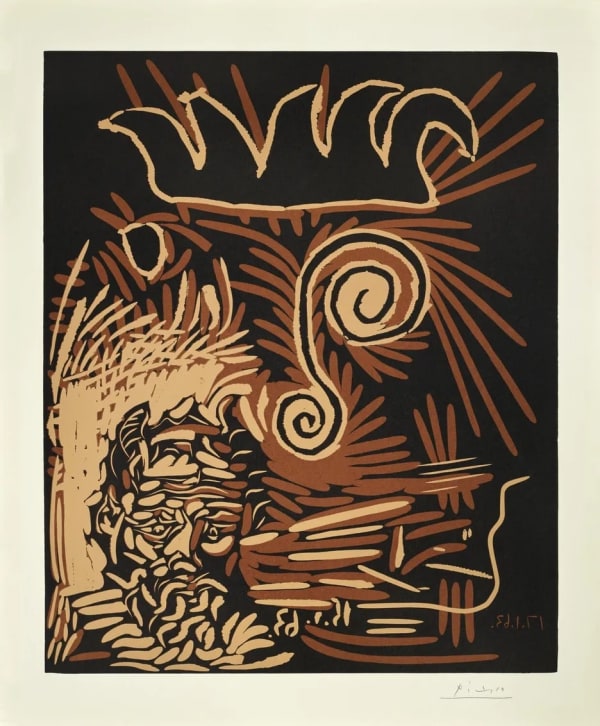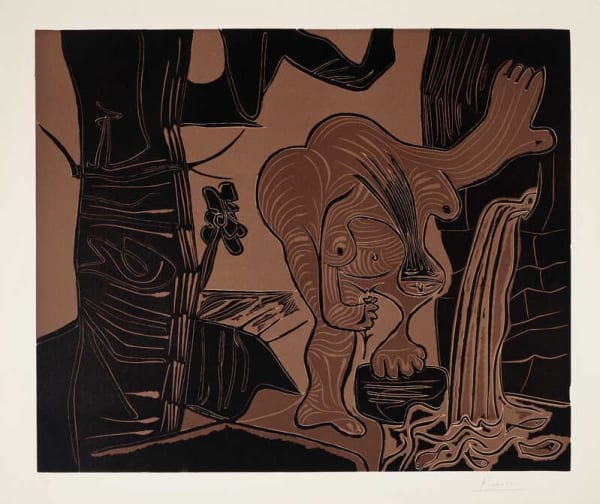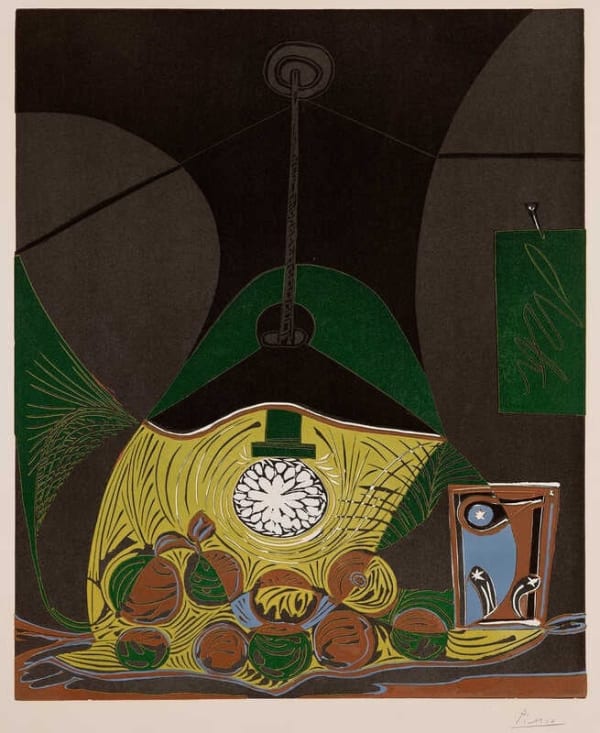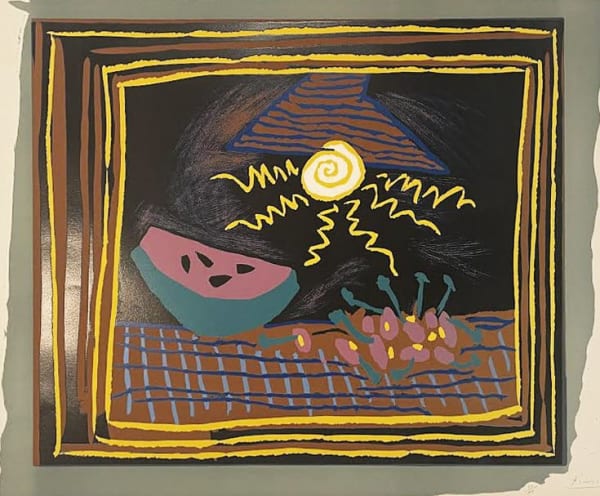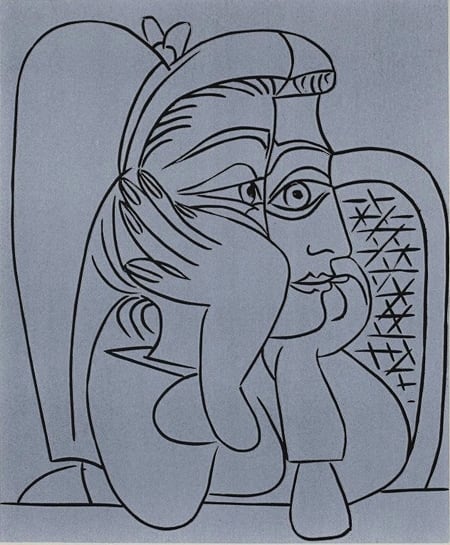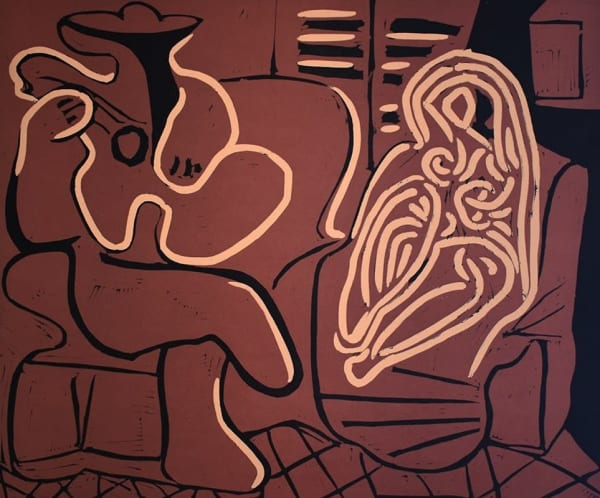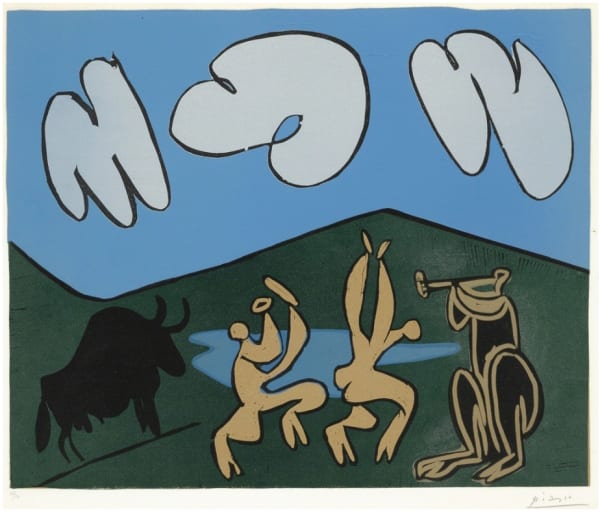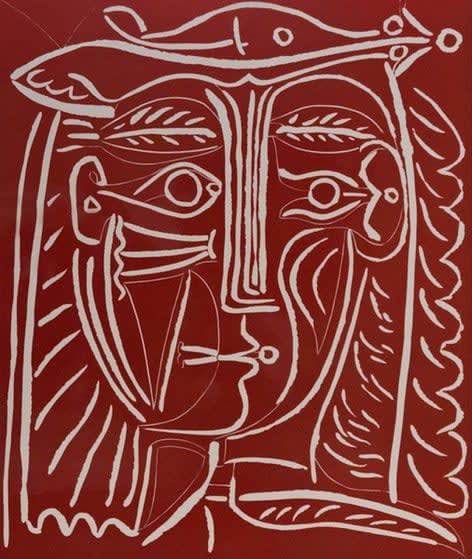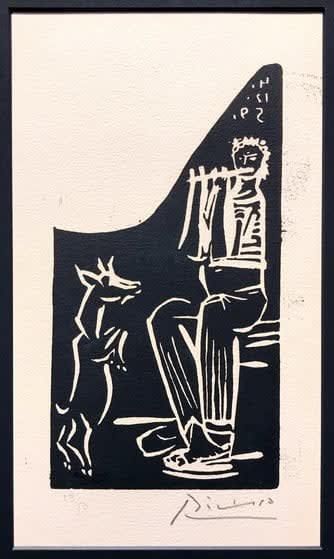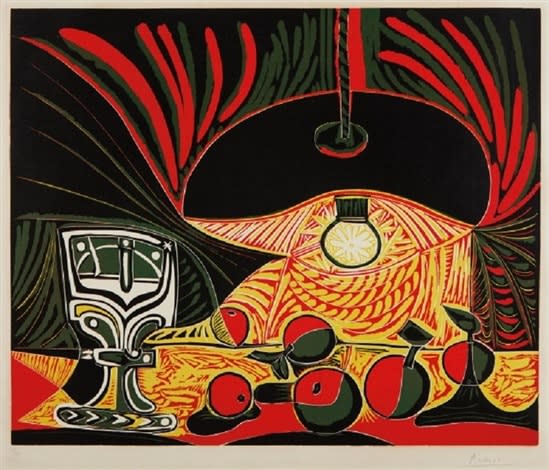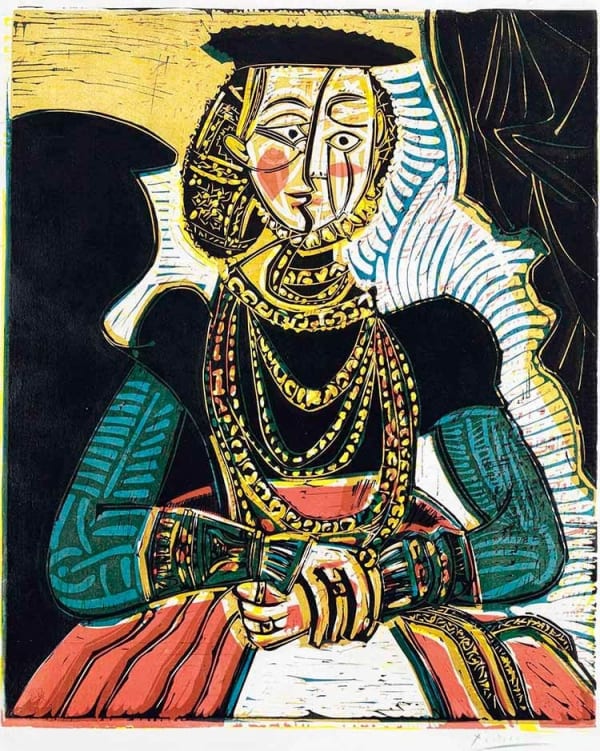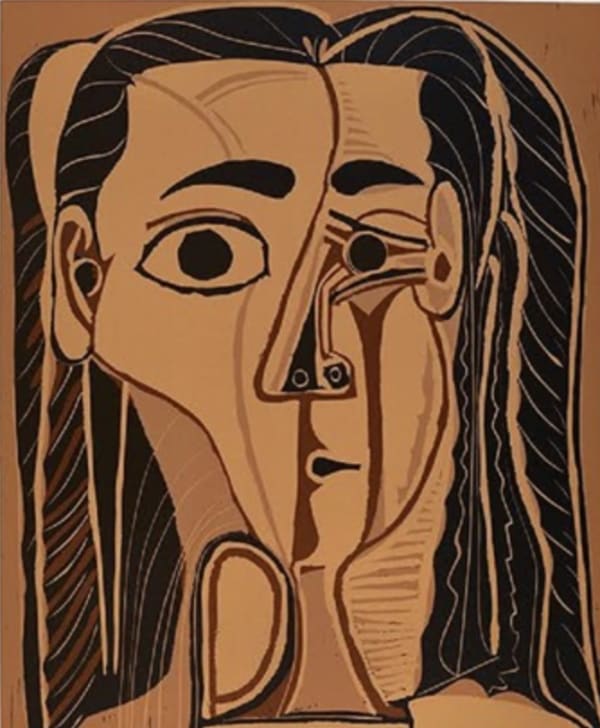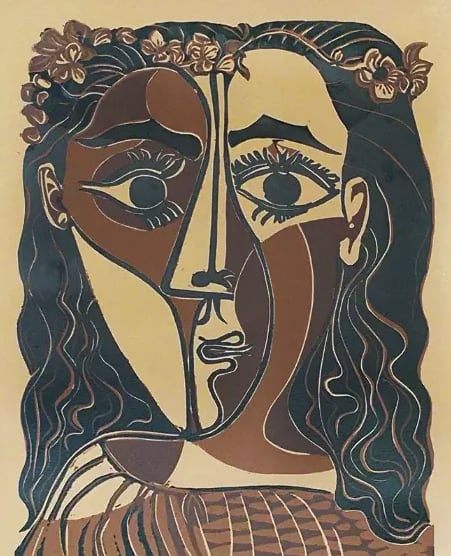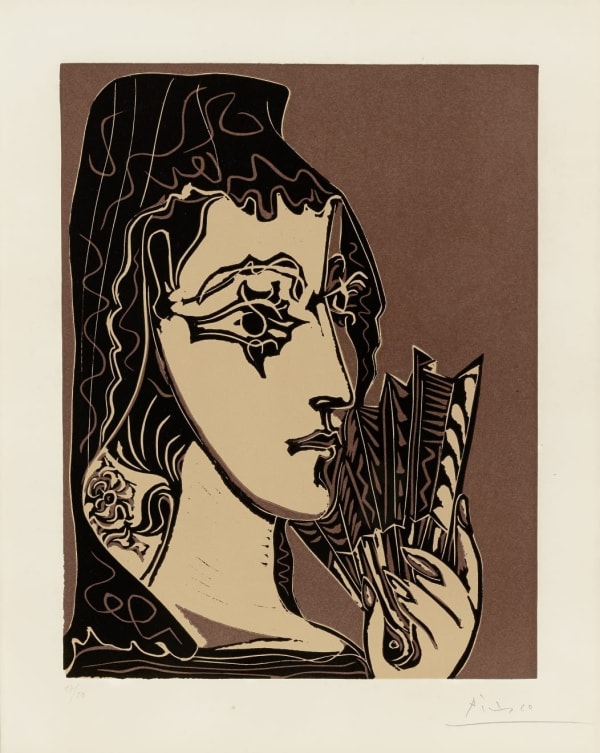
Pablo Picasso
Signed lower right
Titled lower left
52.7 x 64 cm
Taureau et Picador (Bull and Picador) is a commanding example of Pablo Picasso’s late-period mastery of linocut printmaking. Bold, rhythmic, and steeped in Spanish cultural symbolism, the work encapsulates Picasso’s lifelong fascination with the bullfight while showcasing his extraordinary inventiveness within the linocut medium. Created in the 1950s–60s—a time when Picasso was actively collaborating with printers in the South of France—this print exemplifies the artist’s ability to merge tradition and modernism into a striking visual language of power and motion.
The composition is striking for its stylised, almost mythological depiction of a bullfight. A powerful black bull, caught in mid-leap, occupies the left half of the image, its curving form outlined with fluid, economical lines. Opposite it, the picador—mounted on a muscular horse—drives a lance forward with ceremonial posture. The scene is both dynamic and composed, conveying motion through sweeping curves while retaining the monumentality of classical frieze.
Picasso limits his palette to earthy tones: rich black, sienna, and ochre. The stark contrast between dark and light enhances the drama of the image, while the flat areas of colour—typical of linocut—emphasise form over texture. The elegance of the horse, the menace of the bull, and the stoic poise of the picador are stylised into abstract shapes that dance across the surface in a harmonious, almost musical composition.
This stylisation borders on abstraction. The bull’s head is angular, mask-like; the horse’s muscles are simplified into looping forms; the picador’s hat and costume evoke classical Spanish dress, but reduced to emblematic symbols. Yet the work loses none of its emotional impact—in fact, its power is heightened by this distillation.
The bullfight (corrida) is one of the most enduring motifs in Picasso’s oeuvre, appearing from his early Blue Period through his last decades. For Picasso, the bullfight was more than a spectacle—it was a ritual of life, death, and artistic creation. The bull symbolised primal energy and masculine power, while the matador or picador often stood as an allegorical self-portrait: the artist as hero, manipulator, and sacrificer.
In Taureau et Picador, the encounter between man and beast is stylised into a timeless drama. This is not merely a depiction of a cultural tradition, but an existential dance—structured, brutal, and sublime. The arena is suggested but not shown; all attention is focused on the figures, locked in a moment of tension that transcends narrative.
Linocut, a relief printing process using carved linoleum blocks, became a favourite medium for Picasso in the 1950s, especially during his time in Vallauris and Mougins. Collaborating with the printer Hidalgo Arnéra, Picasso pushed the technical boundaries of the medium, inventing new ways to layer colour and re-cut the same block for successive impressions.
Traditionally seen as a modest, almost amateur medium, linocut was elevated by Picasso to a form of sophisticated expression. In Taureau et Picador, he demonstrates total control over the carving process—using sweeping lines, minimal incisions, and refined colour separations to achieve a fluid, sculptural quality.
His approach to linocut was intuitive and sculptural, treating the plate as a subtractive drawing process. The resulting prints are bold, direct, and emblematic—capable of evoking myth and metaphor in a language of refined simplicity.
Taureau et Picador is a masterwork of modern printmaking and a quintessential statement of Picasso’s artistic identity. With this linocut, he transforms a traditional Spanish subject into an abstracted, symbolic encounter of raw force and poised control. It embodies his late-career brilliance—his ability to strip away detail and arrive at an image that is as ancient as it is modern, as stylised as it is visceral. In both form and meaning, it stands as a testament to Picasso’s genius as a draftsman, storyteller, and printmaker without peer.
For more information, contact our galleries via the inquiry form below.
-
 Pablo PicassoTwo Women by the Window | Deux femmes près de la fenêtre, 1959
Pablo PicassoTwo Women by the Window | Deux femmes près de la fenêtre, 1959 -
 Pablo PicassoWoman Reclining and Man with a Guitar | Femme couchée et homme à la guitare, , 1959
Pablo PicassoWoman Reclining and Man with a Guitar | Femme couchée et homme à la guitare, , 1959 -
 Pablo PicassoJacqueline au chapeau de paille, 1962
Pablo PicassoJacqueline au chapeau de paille, 1962 -
 Pablo PicassoLe Vieux bouffon, 1963
Pablo PicassoLe Vieux bouffon, 1963 -
 Pablo PicassoHomme au batôn / Le Vieux bouffon, 1963
Pablo PicassoHomme au batôn / Le Vieux bouffon, 1963 -
 Pablo PicassoFemme nue à la source, 1963
Pablo PicassoFemme nue à la source, 1963 -
 Pablo PicassoNature morte à la suspension, 26 mars, 1962
Pablo PicassoNature morte à la suspension, 26 mars, 1962 -
 Pablo PicassoNature Morte a la Pasteque, 1962
Pablo PicassoNature Morte a la Pasteque, 1962 -
 Pablo PicassoLe Vieux Roi (B. 1152) (The Old King) , 1963
Pablo PicassoLe Vieux Roi (B. 1152) (The Old King) , 1963 -
 Pablo PicassoBoy with a Crown of Leaves | Jeune homme couronné de feuillage, 1959
Pablo PicassoBoy with a Crown of Leaves | Jeune homme couronné de feuillage, 1959 -
 Pablo PicassoLe Déjeuner sur l'herbe d'aprés Edouard Manet. (The Luncheon on the Grass after Edouard Manet), 1954
Pablo PicassoLe Déjeuner sur l'herbe d'aprés Edouard Manet. (The Luncheon on the Grass after Edouard Manet), 1954 -
 Pablo PicassoFemme Accoudée (Bloch 922) , 1959
Pablo PicassoFemme Accoudée (Bloch 922) , 1959 -
 Pablo PicassoLes vendangeurs, 1959
Pablo PicassoLes vendangeurs, 1959 -
 Pablo PicassoL'Aubade, avec Femme Accoudee, 1959
Pablo PicassoL'Aubade, avec Femme Accoudee, 1959 -
 Pablo PicassoAubade, with a Woman in an Armchair | L'aubade, avec femme dans un fauteuil, 1959
Pablo PicassoAubade, with a Woman in an Armchair | L'aubade, avec femme dans un fauteuil, 1959 -
 Pablo PicassoFemme au Chapeau (Portrait de Jacqueline au chapeau de paille multicolore)., 1962
Pablo PicassoFemme au Chapeau (Portrait de Jacqueline au chapeau de paille multicolore)., 1962 -
 Pablo PicassoJacqueline au Bandeau, 1962
Pablo PicassoJacqueline au Bandeau, 1962 -
 Pablo PicassoWatermelon Still Life, 1962
Pablo PicassoWatermelon Still Life, 1962 -
 Pablo PicassoDeux Femmes Prés de la Fenêtre , 1959
Pablo PicassoDeux Femmes Prés de la Fenêtre , 1959 -
 Pablo PicassoBacchanale au Hibou (bloch 938), 1959
Pablo PicassoBacchanale au Hibou (bloch 938), 1959 -
 Pablo PicassoBacchanale au Taureau Noir (Bloch 935), 1959
Pablo PicassoBacchanale au Taureau Noir (Bloch 935), 1959 -
 Pablo PicassoTête de Femme au Chapeau , 1962
Pablo PicassoTête de Femme au Chapeau , 1962 -
 Pablo PicassoFaune et Chévre, 1959
Pablo PicassoFaune et Chévre, 1959 -
 Pablo PicassoPortrait de Femme a la Fraise et au Chapeau , 1962
Pablo PicassoPortrait de Femme a la Fraise et au Chapeau , 1962 -
 Pablo PicassoL'Etreinte (Bloch 1150), 1963
Pablo PicassoL'Etreinte (Bloch 1150), 1963 -
 Pablo PicassoNu Assis, 1962
Pablo PicassoNu Assis, 1962 -
 Pablo PicassoPortrait De Jacqueline (Bloch 923), 1959
Pablo PicassoPortrait De Jacqueline (Bloch 923), 1959 -
 Pablo PicassoPortrait de Jacqueline Au Chapeau De Paille Fleuri, 1962
Pablo PicassoPortrait de Jacqueline Au Chapeau De Paille Fleuri, 1962 -
 Pablo PicassoLa Pique en Rouge et Jaune (The Bullfight in Red and Yellow), 1959
Pablo PicassoLa Pique en Rouge et Jaune (The Bullfight in Red and Yellow), 1959 -
 Pablo PicassoJacqueline au Bandeau, 1962
Pablo PicassoJacqueline au Bandeau, 1962 -
 Pablo PicassoNature Morte Au Verre Sous La Lampe, 1962
Pablo PicassoNature Morte Au Verre Sous La Lampe, 1962 -
 Pablo PicassoBuste de Femme d'après Cranach le Jeune, (Bloch 859), 1958
Pablo PicassoBuste de Femme d'après Cranach le Jeune, (Bloch 859), 1958 -
 Pablo PicassoPortrait de Jacqueline Accoudée, 1959
Pablo PicassoPortrait de Jacqueline Accoudée, 1959 -
 Pablo PicassoGrande Tete De Femme (Bloch 1069), 1962
Pablo PicassoGrande Tete De Femme (Bloch 1069), 1962 -
 Pablo PicassoPetite Tête de Femme Couronnée, `962
Pablo PicassoPetite Tête de Femme Couronnée, `962 -
 Pablo PicassoPortrait de Jacqueline en Carmen (L'Espagnole) , 1962
Pablo PicassoPortrait de Jacqueline en Carmen (L'Espagnole) , 1962
Join our mailing list
* denotes required fields
We will process the personal data you have supplied in accordance with our privacy policy (available on request). You can unsubscribe or change your preferences at any time by clicking the link in our emails.
This website uses cookies
This site uses cookies to help make it more useful to you. Find out more about cookies.



